
Wine Culture and Information since 2002 - Volume 22
 Wine Culture and Information since 2002 - Volume 22 |
|
Issue 45, October 2006 |
Contents |
|
|
All Versus All |
|
Marketing, with its rules and laws, as everyone knows, it is rough and ruthless, common sense, which should favor a friendly life together, it is frequently replaced by a less noble competition. Better to say, competition - alone - it is not anything bad in case it is being used in a constructive way, however the border between the “licit” and the “less licit”, between “correctness” and a “lesser correctness”, it is frequently confused. All that in order to pursue the legitimate goal of the economic profit. This is true for every field of marketing, no matter the type of activity done. Does wine make an exception in all that? In order to find the answer, it is enough to take a look at the shelves in wine shops and malls, in the “good words” of producers and the way bottles are “dressed up”, in order to understand wine does not certainly make an exception. Indeed, competition in this field is very tough and ruthless. In the world of wine we can talk about culture, tradition, passion and quality, about noble and romantic stories, however it is indisputable - and, of course, understandable - wine producers must also take care about their own profits. Of course, this is not a fault: it is just understandable. In a society like ours, in which - it cannot be denied and this does not certainly represent a noble aspect - money has too much importance, pursuing a profit is understandable. What it is less understandable, or better to say, less agreeable, is the way the pursuing of profit is masked, even at the cost of selling an illusion to customers, something which is different from and frequently having a lesser value than the real value the object representing the purchase has. This also happens for wine, there is no doubt about this. There are so many bottles out there sold at pretty disputable prices and, once they are being poured in glasses, they express a pretty disappointing quality, pretty “ordinary”, not bad, but however far from their marketing value. Disappointment is even bigger when you find out there are wines sold at lesser prices and objectively expressing a superior quality. What a wonderful thing is comparison, when you have the possibility to make it. In the specific case of wine, there are many factors which can be used as a qualitative comparison: producers, areas, grapes and countries, as to mention few of them. The possibility of making comparisons could compromise, in many cases, the pursuing of a profit, in case it is unfavorable. If you choose something, you will not probably choose, or you will not choose anymore, the other. In an “enlarged” world, where wine is being produced in many countries, the possibility of making comparisons dramatically increases, in particular when the products of the competition are sold at lower prices. As the offer increases, the availability of products to choose increases as well, the competition then becomes tougher, fought with any weapon, in order to be in a shinier light than the others and in order to be chosen, in other word, to make a profit. Competition certainly is a positive thing in case it is used in an intelligent way and in order to improve something, in case it is used critically, it helps to improve the quality of things. As we live in an imperfect world, sometimes too much imperfect, competition, in its worst expression, frequently leads to a non truly noble confrontation, where the only thing seen, in this obtuse blindness, is one's own profit and interest. And it is not just about economic interest only, but also cultural, traditional and historical: not only for money clashes arise. Men are extraordinarily good to to make contrasts in order to affirm themselves and their “cultures” over the others. Millennia of history told us how much “civilized” was, and continues to be, the social progress in this sense. Man seems not to understand it is less hard to listen and to understand, to take advantage of the richness of mutual differences and to try to live without contrasts, instead of making wars. For this reason are used countermeasures which initially involve a small number of competitors living in the same area, then it floods in the neighboring areas, in a process which progressively involves a whole region, a whole country, the entire world. In the world of wine, this competition is expressed in different ways, and one should ask oneself, when it is expressed in the negative form of contrast only, how much this benefits wine and the ones who like it. Chardonnay versus Sauvignon Blanc, Gewürztraminer versus Riesling, Merlot versus Sangiovese, Cabernet Sauvignon versus Zinfandel: the examples can go on and on. Moreover, the conflict also involves other ways as well: a producer versus another, a wine area versus another, a region versus another, a country versus another, all of them being convinced what they have is better than anything else. To make things even sadder, most of the times one does not realize he or she knows little about what one has, nevertheless, what the others have. If we begin to understand everyone has something to learn from anyone, and that everything indisputably has good and bad qualities which make it absolutely unique, we would probably fear less what we do not know. Chardonnay, for example, is a grape having good and bad qualities, and the same is true for Sauvignon Blanc and for any other grape. With what absolute criterion can be said what is the best one of the two as to make a holy crusade? Taste, which certainly is important and could answer this question, does not represent - as a matter of fact - an absolute criterion: it simply is a relative and subjective opinion. However, as it represents an opinion in which can be recognized the personality of the one who expresses it, this can lead to contrast among wine lovers as well. For example, there are many people who believe the only wine worth to be considered as such is red wine, the rest is not even seen. Even worst, most of the times, these are considerations expressed without cause, as the quality of the other type of wines is unknown, they are simply excluded without even knowing them. Contrasts of this kind can also be seen in certain wines, considered by their supporters as the only ones worth of consideration, in a way they refuse to think about looking beyond, as this would be bad for their dignity and integrity of expert. All versus all, only for the purpose of affirming oneself and something which is considered to be better than the rest. Does this really benefits wine?
|
||||
MailBox |
|
In this column are published our reader's mail. If you have any comment or any
question or just want to express your opinion about wine, send your letters to
our editorial or fill in
the form available at
our site.
|
| What does make a good wine? In my opinion it depends on the meteorological condition of the year, whereas my partner says it depends on alcohol content. Who's right? |
| Nicola Parker -- Malaga (Spain) |
| The question, in its simplicity, is complex and would require a complex answer. Meteorological conditions of the year represent one of the many factors - certainly among the most important ones - allowing the production of a good wine. There are also other indispensable factors for the production of a good wine, of these, the most important ones include the quality of grape - which also depends on the meteorological condition of the year - production area, wine making technique and therefore the intervention of man. The quantity of alcohol in a wine, alone, is not enough to make quality. It would be like saying all fortified wines, which can also have alcohol by volume of 19%, would implicitly be good, something which is not true. Alcohol content is however essential for the quality of wine, both for ensuring a good organoleptic balance, as well as to improve the development and perception of aromas. |
| What is the difference between grappa and grape brandy? |
| Gianluca Matteini -- Siena (Italy) |
| Despite grappa and grape brandy are both produced with grape, or better to say, with specific parts of the grape properly processed, they are different. Grappa is produced with the distillation of grape pomace only, that is the skins, rich in precious aromas which will give grappa its smell, properly fermented. In the production of grappa are used both pomace of white grapes and pomace of red grapes. As the pomace of white grape is being separated from the must before alcoholic fermentation will transform it into wine, it is indispensable they are fermented before distillation in order to get alcohol. As in the production of red wine pomace is being macerated with the must during fermentation, when they are separated from wine, they contain alcohol, in other words, they are ready for distillation. Grape brandy is produced with the distillation of fermented grape, that is fresh fermented must. In this specific case, grape is considered - rightly - like any other fruit used for the production of fruit brandies. Despite grappa is a distillate, it cannot be called fruit brandy, because of the differences in the production of the two distillates. Grappa can be correctly defined as pomace brandy. |
CampaniaGreco di Tufo, Fiano di Avellino and Taurasi: the three most famous wines of Campania, expression of three extraordinary white and red grapes, excellent representatives of an ancient wine culture |
|
Campania is an enchanting region according to many aspects. History, culture, art and tradition, have always distinguished this ancient land in every aspect of the social life of its people. In culture and tradition of Campania, wine and food have always played a fundamental role, an indissoluble element with the history of this region. According to a viticultural point of view, Campania is a land capable of telling tens of charming stories in the form of the many autochthonous grapes of this region and the many wines for which it is famous, including Falerno, one of the most ancient wines in Italy and which honored the enology of the boot even before the times of ancient Romans. Despite how much the history of Falerno wine can be enchanting, Campania is more than that, a group of small and big local realities, each of them expression of an absolutely unique world and tradition. Wine making tradition in Campania has very ancient origins dated back before the times of ancient Romans. It will however be during the period of the Roman Empire Campania will begin to flourish and develop, its wines will also be shipped outside the borders of our country. It is said ancient Romans, and in particular Roman emperors, had a particular predilection for wines from Campania. Thanks to the favorable climate conditions and the particular quality of the soil, in this region have formed very good conditions for the cultivation of vine and the production of wine. Many famous wines of the past were produced in Campania: Caleno, Faustiniano and, in particular, Falerno, considered at those times a very precious wines as to have no rivals. In fact, many authors of those times praised the qualities of Falerno wine, including Pliny the Elder. The enological splendor of Campania at those times also allowed the development and the improvement of viticultural and wine making practices.
The history of the enology in Campania began with the arrival of ancient Greeks in the lands which will be later called Magna Graecia. It is very likely it were Greeks who introduced seeds of vitis vinifera in Campania, as most of the grapes today considered as autochthonous have Greek origins. The main autochthonous grapes of Campania, such as Aglianico, Greco Bianco, Fiano, Falanghina, Biancolella and Piedirosso, are probably of Greek origins. In particular Aglianico, whose name is supposed to come from the ancient city of Elea (the modern Novi Velia) and therefore Eleanico, or from the corruption of the name Ellenico, that is “from Greece”. The influence in wine making cultures of ancient Greeks is still today visible in the cultivation techniques of “alberello” and in the way vines are pruned. The contribution of Greeks will be fundamental for the success of Campanian wines in Roman times. During Roman times, Pompeii become a very important city for wine, not only for the considerable number of taverns present here - and in which Falerno was always found - in particular for being the main commercial city in Campania for the trading of wine. From the ports of Pozzuoli and Sinuessa were in fact shipped tens of thousands hectoliters of wines to the countries of the Mediterranean countries and Gaul. The prestige of Falerno was such that an amphora of this wine could even cost the price of a slave. Unfortunately, of the ancient Falerno there are no reliable information about its production and in particular its grapes. Pliny the Elder wrote this wine was produced with the Falerna or Falernina grape, whereas Virgil supported the idea it was produced with the ancient Aminee grapes coming from Tessalia. The prestige of the renowned Falerno ended with the fate of Roman empire: from excellent wine it became an unknown wine with a deplorable worsening in quality. With the end of Roman empire, begins the decay of Campanian enology: from producers of great and refined wines, it quickly became an area completely uninterested in wines, up to Medieval times, one of the darkest periods for vine and wine of this region. One of the most probable causes for the decay was the fact in Campania - as opposed to what was common elsewhere - the production of wine was mainly done by small producers: here did not happen the strong influence of monasteries and their keeping and development in the wine making. However, also in Medieval times, some of the wines of Campania had a moderate success. At the court of Frederick II was in fact present Fiano and in 1300s was the turn of Asprinio, still cultivated today by some producers according to the ancient “married vine” training system, a sign of Etruscan culture in these lands. The strong acidity of Asprinio made it clear in 1300s its potentialities for the production of sparkling wines, and in 1700s many French and Hungarian businessmen were coming to Aversa in order to buy grapes to be used for the production of their wines with bubbles. A new success, although modest, for Campanian wines will happen during the renaissance and baroque periods. It was in fact in these periods the enology of Campania was represented by the famous wines Mangiaguerra, Aglianico, Asprinio, Fistignano, Falanghina, Corsara, Cerella, Lagrima, Coda di Cavallo and the many types produced with Greco grapes. The 1700s will see a new decay for Campanian enology, period in which only the appreciated grapes Pallagrello Bianco and Nero caught some interest, and after a period in which they were almost forgotten, they have been recently rediscovered. Despite oidium and phylloxera arrived in Campania in later times than elsewhere, viticulture was drastically damaged. After a non truly noble period, passed between the recovery of the ancient heritage and the introduction of new varieties, Campania enology will resume its development in quality from the 1980s on. In the last twenty years, wines from Campania are getting more and more successful, also catching the attention of many consumers, both for white and red wines. Greco di Tufo, Fiano di Avellino, Falanghina, Taurasi and the many expressions of the powerful Aglianico, are only some of the many grapes making Campania one of the most interesting Italian regions according to a wine making point of view.
|
||||||||||||
|
The wines of Campania, just like any other region in Italy, are classified according to the quality system in force in the country. For many years, the powerful Taurasi was the only wine in Campania to be recognized with the Denominazione d'Origine Controllata e Garantita (Denomination of Controlled and Guaranteed Origin). As of 2003, Taurasi is not alone in this category anymore, as it was joined in the DOCG category also by the two other pearls of regional enology: Greco di Tufo and Fiano di Avellino. In the region are also produced interesting wines classified in the category of Indicazione Geografica Tipica (IGT) (Geographical Typical Indication), produced both with autochthonous and “international” grapes. In Campania are currently defined 18 Denominazione d'Origine Controllata areas (Denomination of Controlled Origin): Aglianico del Taburno, Aversa, Campi Flegrei, Capri, Castel San Lorenzo, Cilento, Costa d'Amalfi, Falerno del Massico, Galluccio, Guardiolo or Guardia Sanframondi, Irpinia, Ischia, Penisola Sorrentina, Sannio, Sant'Agata dei Goti, Solopaca, Taburno and Vesuvio.
|
|
Wine production in Campania is made all over the region, however there is a higher concentration in the provinces of Avellino - area from which come Taurasi, Greco di Tufo and Fiano di Avellino - and Benevento, whose wines mainly belong to the interesting Sannio and Taburno DOCs. The ampelographic heritage of Campania is extremely rich, in particular of autochthonous grapes, which after having been ignored for years in favor of “international” varieties - and the same was happening in other Italian region as well - in the 1990s they have been rediscovered and revaluated the way they certainly deserve. The most interesting wines in Campania are in fact produced with autochthonous grapes, both white and red, an authentic treasure of which the region takes advantage, therefore characterizing the enological production of Campania. In this sense, the example of Campania should also be followed elsewhere in Italy, as every region of the boot is rich in autochthonous grapes which could made every wine area absolutely unique. In wines produced in Campania it is in fact pretty rare to find in blends the presence of “international” grapes: the part of the protagonist in this region goes to autochthonous grapes. Among autochthonous white berried grapes of Campania are mentioned Asprinio, Falanghina, Fiano, Greco Bianco, Coda di Volpe, Pallagrello Bianco, Biancolella and Forastera. Also interesting the group of the autochthonous red berried grapes, beginning with Aglianico - the king of this region - to which are joined Piedirosso (here called Per'e Palummo, Pigeon foot), Sciascinoso, Pallagrello Nero and Casavecchia. In particular, Casavecchia, which was forgotten for years and recently revaluated with very good results, is a grape with excellent qualities capable of making wines of good elegance and deeply colored, as its content in anthocyanins is higher than Aglianico. Among the wine areas in Campania, a particular mention should go to the heroic and tenacious viticulture done in the islands of the region, in particular Ischia, in which it is found a production of excellent white wines with Biancolella and Forastera grapes.
|
|
Aglianico is the grape which more than any other else, has allowed red wines of Campania to be known outside regional borders. Despite Aglianico is cultivated everywhere in this region, the most typical area is Irpinia, in the province of Avellino, where it is being produced the most representative red wine of Campania: Taurasi. Also known as the Barolo from the South, Taurasi is a wine produced with 100% Aglianico, very rich, concentrated and complex, elegant and surprising: a wine which hardly goes unnoticed to connoisseurs. In Campania, Aglianico does not mean Taurasi only. With this excellent grape are in fact produced the interesting red wines of Taburno as well, in the province of Benevento, another good area for red wines produced with this grape. In the province of Benevento, Aglianico is also the protagonist of the reds in the Sannio area. Moreover, Aglianico is also the main grape for the production of wines in the DOC area of Falerno del Massico, in the province of Caserta.
|
|
Among the many white wines of Campania, two in particular have become successful outside this region, also obtaining, in 2003, the Denominazione d'Origine Controllata e Garantita status (DOCG, Denomination of Controlled and Guaranteed Origin). Greco di Tufo and Fiano di Avellino, both produced in the province of Avellino, are in fact the most famous white wines of Campania, including the ones produced with the excellent Falanghina. Greco di Tufo, which takes its name from the homonymous village and which is also produced as a sparkling wine, is mainly made with Greco Bianco grape and a small percentage of Coda di Volpe, it is a dry white wine with good body and pretty crisp. Fiano di Avellino is more aromatic, thanks to the contribution of the homonymous grape, which Latins were used to call Apianum (bee's grape), because bees were used to stay in hanged clusters to be dried for the production of sweet wines. Fiano di Avellino is an elegant wine with surprising aromas, however complex and with a good body, which is sometimes enhanced by the aging in cask, a technique used by some local producers.
|
|
There are many interesting wine areas in Campania, including the ones in province of Caserta, in particular Aversa, homeland of the famous Asprinio, and Falerno del Massico, the area which keeps alive, although with completely different wines, the glorious past of the renowned wine which was appreciated in ancient times. The area of Vesuvio is distinguished for its Lacryma Christi, appreciated in the 1500s as a sweet wine, today it is mainly produced as a dry white, red or rose wine. Of particular interest is the enchanting island of Ischia where are being produced excellent white wines with Forastera and Biancolella grapes, and reds with Piedirosso grape. In the area of Benevento is to be mentioned the wide area of Sannio, where are found many cooperative wineries, and from which are being produced interesting white and red wines. A particular mention goes to the revaluation of three ancient grapes and that today, thanks to the tenacity of few producers in the province of Caserta, continue to give pleasing and interesting wines: Pallagrello Bianco, Pallagrello Nero and Casavecchia.
|
Comparing Pinot BlancComing from Bourgogne and sometimes confused with Chardonnay, Pinot Blanc is a grape now common all over Europe with which are being produced classic method sparkling wines as well |
|
Pinot Blanc is one of the many grapes belonging to the rich family of Pinots. Coming from Bourgogne - just like the other members of this family - Pinot Blanc is considered a mutation of Pinot Gris, which is in turn considered a mutation of Pinot Noir. The fate of Chardonnay - another grape coming from Bourgogne - has a connection with Pinot Blanc. Chardonnay is in fact sometimes called - erroneously, of course - Pinot Chardonnay, even worse, it is sometimes completely confused with Pinot Blanc because of their similarities. In fact, for years Chardonnay has been confused with Pinot Blanc, an ambiguity that today, luckily, seems to be clear everywhere in the world. Also the use of Pinot Blanc in the production of wine is pretty similar to Chardonnay. Thanks to its high acidity it is in fact used for the production of classic method sparkling wines - such as Franciacorta, for example - and in past times it was used in the production of Champagne, a custom which is today used by few producers. Despite the origin of Pinot Blanc is from Bourgogne, today this grape is mainly cultivated in central Europe and Austria, where it is commonly known as Weissburgunder and from which are obtained good wines. In France, Pinot Blanc is currently represented by Alsace, where it is cultivated a particular clone - called Gros Pinot Blanc - capable of a higher productivity and vigor. Pinot Blanc is common in Eastern Europe and in California. In Italy, Pinot Blanc is pretty common, in particular in the regions with a cool climate, such as Alto Adige, Veneto, Trentino, Lombardy and Friuli Venezia Giulia. In these regions Pinot Blanc is also used for the production of classic method sparkling wines, such as Franciacorta, Talento and Trento Spumante. In the production of dry wines, Pinot Blanc is generally fermented and aged in steel tanks, however there are many cases in which it is preferred the aging in cask, in particular the barrique. The passage in wood, of course, gives Pinot Blanc a fuller body and longevity, while losing part of its aromatic characteristic.
|
|
Because of its relatively weak aromatic characteristics, quality wines produced with Pinot Blanc requires strict cultural practices. The low aromaticity of ordinary and average quality Pinot Blanc, made connoisseurs believe the wines produced with this grape were not interesting, a reason which probably led to the use of cask by many producers. Pinot Blanc has however other qualities which make it interesting for the production of wines, in particular in case it is blended with other grapes: good acidity and good body. Its good structure has also contributed, among the other things, to confuse Pinot Blanc with Chardonnay, two grapes having nothing in common. The relatively low aromaticity and its high acidity, make in fact Pinot Blanc interesting for the production of classic method sparkling wines, more frequently, for the production of Charmat method sparkling wines.
Our comparative tasting about Pinot Blanc will use three Italian wines, coming from two regions which are considered among the most representatives in Italy for the production of wines made with this grape: Alto Adige and Friuli Venezia Giulia. The wines have also been chosen according to the vinification technique, in order to understand the role of the cask in Pinot Blanc. The first wine selected for our comparative tasting is Scubla's Colli Orientali del Friuli Pinot Bianco di Scubla, aged for 8 months in steel tanks. The second wine, fermented and aged in steel tanks as well, is Franz Haas's Alto Adige Pinot Bianco. The last wine is the only Pinot Blanc of the three to be aged in barrique, where it remains for a period of 12 months: Castello di Spessa's Collio Pinot Bianco di Santarosa. The first two wines will be tasted at a temperature of 10° C (50° F), whereas for the third one we will be chosen a temperature of 12° C (54° F). The comparative tasting will be made, as usual, by using three ISO tasting glasses.
|
||||||||
|
The color which can be observed in wines produced with Pinot Blanc is, as usual, a factor also depending on wine making technique, in particular on the types on containers used for fermentation and aging. In case vinification was completely made in inert containers - steel or cement tanks - Pinot Blanc does not show hues of intense color, generally ranging from a more or less intense greenish yellow color to pale straw yellow, with greenish yellow nuances. In case fermentation or aging was made in wood casks, the color gets deeper intensities, from intense straw yellow to golden yellow, and also nuances get a straw yellow color. When vinified with quality criteria, Pinot Blanc - thanks to its good acidity and body - can stand to some years of aging in bottle, period in which its color will get a deeper intensity which can also be of deep golden yellow. The first wine of which we will evaluate appearance is Franz Haas's Alto Adige Pinot Bianco. By holding the glass titled on a white surface, it will be observed the wine at the base of the liquid mass, where it will be possible to see an intense greenish yellow color, almost brilliant. By observing the wine towards the opening of the glass, it will be seen a nuance of the same color. Let's now examine Scubla's Colli Orientali del Friuli Pinot Bianco: also in this case the color, observed at the base of the glass, will show a brilliant greenish yellow hue and nuances of the same color. Let's now observe the appearance of the third wine, Castello di Spessa's Collio Pinot Bianco di Santarosa. At the base of the glass, tilted on a white surface, it will be observed a pale golden yellow color, an evident sign of the passage in barrique for this wine, a factor which is also seen in its straw yellow nuance.
|
|
Pinot Blanc is frequently considered a grape from which are produced not very aromatic wines, or however not very rich in aroma varieties. Indeed, when quality production criteria are being adopted - something which is of course true for every grape, every wine and every area - wines produced with Pinot Blanc give interesting surprises also in aromas. The world of Pinot Blancs is mainly made by aromas belonging to the family of fruits, including tropical fruits, as well as the ones belonging to the world of flowers. Among the fruit aromas which can be perceived in Pinot Blanc wines, the most frequent ones are apple, peach, pear, plum and lemon, whereas as for tropical fruit aromas, the most common ones are banana, grapefruit and litchi. Also aromas of dried fruits can be sometimes found in Pinot Blanc, in particular almond and hazelnut. The most common flower aromas are the ones of broom, hawthorn, acacia and, sometimes, jasmine. The first wine of which we will evaluate aromas is Scubla's Colli Orientali del Friuli Pinot Bianco. By holding the glass in vertical position, and without swirling, we will proceed with the evaluation of opening aromas. After the first smell, it will be possible to perceive from the glass aromas of pear and lemon, two typical aromas distinguishing Pinot Blanc. After having swirled the glass, in order to favor a proper oxygenation of aromas, we will proceed with the second smell. It will be perceived aromas of hawthorn, pineapple, chamomile, apple, peach and broom, also in this case, pretty typical aromas in Pinot Blanc, including the most typical aroma of tropical fruit in this grape: pineapple. It should be noticed how the aromatic balance in this wine is very good: the perception of aromas is very clean. Let's now examine the aromas of the second wine Franz Haas's Alto Adige Pinot Bianco. We will proceed with the evaluation of opening aromas, an operation that will be done, as usual, by holding the glass still and in vertical position. After the first smell it will be perceived aromas of pear, almond and plum. Besides pear, that in Pinot Blanc is very frequent, in this wine we will find the most typical aroma of dried fruit: almond. After having swirled the glass, we will proceed now with the second smell from which will be perceived aromas of hawthorn, pineapple, broom, lemon and peach. Let's now examine the last wine, Castello di Spessa's Collio Pinot Bianco di Santarosa, the only wine of the three aged in barrique. Opening aromas will be characterized by banana, plum and toasted wood, whereas the second smell, after having swirled the glass, will develop aromas of pineapple, apple, hazelnut, pear, grapefruit, hawthorn and, pleasingly perceptible, hints of lavender. It should be noticed how in this last wine, despite the passage in wood is evident, this does not excessively disturb the perception of other aromas.
|
||||
|
Among the main characteristics which can be found during the gustatory evaluation of wines produced with Pinot Blanc, the most evident ones are represented by the high dry taste, good acidity and body. The latter two qualities make Pinot Blanc particularly appreciated in the production of classic method sparkling wines, such as Franciacorta and Talento. Pinot Blanc does not attract classic method sparkling wine producers only. Thanks to its acidity and its appreciable body, it is also used blended with other grapes having a lower structure, such as Sauvignon Blanc, or with not very high acidity, as in case of Chardonnay. Because of these two primary organoleptic characteristics, in particular when it is vinified without making use of specific qualitative criteria, wines produced with Pinot Blanc, during the gustatory analysis, can be pretty harsh, dry, with high acidity and body. For this reason, some producers prefer to vinify Pinot Blanc by using the barrique, in order to make it smoother therefore limiting the aggressivity of acids. The first wine we will evaluate is Scubla's Colli Orientali del Friuli Pinot Bianco. The attack, evaluated at the first sip, will be characterized by the evident and pleasing crispness, and it should also be noticed, moreover, the good structure and the correspondence to the nose of pear flavor. Let's now evaluate the second wine, Franz Haas's Alto Adige Pinot Bianco. Just like the previous wine, the attack of Franz Haas's Pinot Blanc will be characterized by an evident crispness given by acidity, higher than the previous wine. It should also be noticed the good structure of the wine and the correspondence to the nose of the opening aromas. Let's now pass to the gustatory evaluation of the last wine, Castello di Spessa's Collio Pinot Bianco di Santarosa. The attack, despite acidity is still well appreciable, it will be lower but however well balanced by the higher smoothness and structure - sign of the passage in barrique - which together with alcohol, make the wine very harmonic. Just like in the previous cases, it should be noticed the good correspondence to the nose with the opening aromas.
|
|
The three Pinot Blancs of our comparative tasting allowed us to appreciate the main organoleptic qualities of this grape. Three wines produced in different areas and in different ways, however all being good expressions of Pinot Blanc. The finish in Scubla's Colli Orientali del Friuli Pinot Bianco is characterized by flavors of pear, peach and apple, qualities which distinguish Pinot Blanc, in particular pear and apple. The finish of Franz Haas's Alto Adige Pinot Bianco is also persistent with evident flavors of pear and apple as well as plum. The finish of the third wine, Castello di Spessa's Collio Pinot Bianco di Santarosa is characterized, as opposed to the previous wines, by a higher complexity and structure, thanks to the aging in barrique. The finish of this wine is persistent and leave in the mouth flavors of plum, pear, banana and hazelnut, very intense and elegant. Because of its organoleptic qualities, Pinot Blanc is mainly blended with other grapes, however the wines of our comparative tasting prove that, when vinified with quality criteria, it can give very good results also on its own.
|
Wines of the Month |
|
|
|
Score legend Prices are to be considered as indicative. Prices may vary according to the country or the shop where wines are bought |
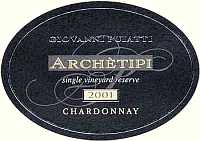
|
|
Collio Chardonnay Archetipi 2001 |
|
| Giovanni Puiatti (Friuli Venezia Giulia, Italy) | |
| Grapes: Chardonnay | |
| Price: € 19.00 | Score: |
| Chardonnay Archetipi shows a brilliant straw yellow color and nuances of straw yellow, very transparent. The nose reveals intense, clean, pleasing and refined aromas which start with hints of banana and apple followed by aromas of acacia, pineapple, plum, bread crust, hawthorn, litchi, hazelnut, grapefruit and pear. The mouth has good correspondence to the nose, a crisp attack and however balanced by alcohol, good body, intense flavors, agreeable smoothness. The finish is persistent with flavors of banana, plum and apple. Chardonnay Archetipi ages in steel tanks. | |
| Food Match: Roasted fish, Broiled fish, Roasted white meat, Stuffed pasta | |
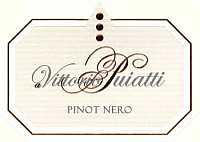
|
|
Oltre Pinot Nero a Vittorio Puiatti 2003 |
|
| Giovanni Puiatti (Friuli Venezia Giulia, Italy) | |
| Grapes: Pinot Noir | |
| Price: € 21.00 | Score: |
| The wine shows a brilliant ruby red color and nuances of brick red, moderate transparency. The nose denotes intense, clean, pleasing and refined aromas which start with hints of cherry, raspberry and plum followed by aromas of strawberry, cyclamen, blueberry, rose, cinnamon, pink pepper and menthol. The mouth has good correspondence to the nose, a slightly tannic attack and pleasing crispness, however balanced by alcohol, good body, intense flavors, agreeable. The finish is persistent with flavors of cherry, plum and raspberry. This Pinot Noir ages in steel tanks. | |
| Food Match: Roasted meat, Stewed and braised meat with mushrooms | |
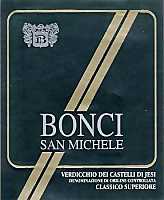
|
|
Verdicchio dei Castelli di Jesi Classico Superiore San Michele 2004 |
|
| Bonci (Marches, Italy) | |
| Grapes: Verdicchio | |
| Price: € 12.00 | Score: |
| The wine shows a brilliant golden yellow color and nuances of golden yellow, very transparent. The nose reveals intense, clean, pleasing and refined aromas which start with hints of apple, plum and almond followed by aromas of hawthorn, pear, citrus fruits, pineapple, honey and grapefruit. The mouth has good correspondence to the nose, a crisp attack and pleasing roundness, however balanced by alcohol, good body, intense flavors. The finish is persistent with flavors of apple, plum and almond. Verdicchio San Michele ages in steel tanks. | |
| Food Match: Roasted fish, Stewed fish with mushrooms, Roasted white meat | |
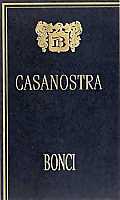
|
|
Casanostra 2002 |
|
| Bonci (Marches, Italy) | |
| Grapes: Montepulciano | |
| Price: € 14.00 | Score: |
| Casanostra shows an intense ruby red color and nuances of garnet red, little transparency. The nose denotes intense, clean, pleasing and refined aromas which start with hints of plum jam and black cherry jam followed by aromas of blueberry jam, vanilla, violet, tobacco, licorice, carob, mace and menthol. The mouth has good correspondence to the nose, a tannic attack and however balanced by alcohol, good body, intense flavors, pleasing roundness. The finish is persistent with flavors of plum jam and black cherry jam. Casanostra ages for 1 year in barrique followed by at least 6 months of aging in bottle. | |
| Food Match: Roasted meat, Broiled meat, Braised and stewed meat | |
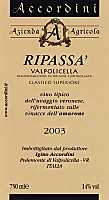
|
|
Valpolicella Classico Superiore Ripassà 2003 |
|
| Accordini Igino (Veneto, Italy) | |
| Grapes: Corvina (55%), Corvinone (20%), Rondinella (15%), Rossignola (10%) | |
| Price: € 12.00 | Score: |
| This wine shows an intense ruby red color and nuances of ruby red, little transparency. The nose reveals intense, clean, pleasing and refined aromas that start with hints of blackberry, black cherry and plum followed by aromas of blueberry, violet, vanilla, tobacco, carob and cinnamon. The mouth has good correspondence to the nose, a tannic attack and however balanced by alcohol, good body, intense flavors, good roundness. The finish is persistent with flavors of plum, black cherry and blackberry. This wine referments in Amarone's pomace according to the “ripasso” method, ages for 12 months in barrique and 6 months in cask. | |
| Food Match: Roasted meat, Braised and stewed meat with mushrooms, Hard cheese | |
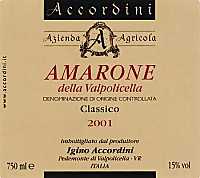
|
|
Amarone della Valpolicella Classico Le Bessole 2001 |
|
| Accordini Igino (Veneto, Italy) | |
| Grapes: Corvina (55%), Corvinone (15%), Rondinella (20%), Rossignola (10%) | |
| Price: € 25.00 | Score: |
| This Amarone shows an intense ruby red color and nuances of garnet red, little transparency. The nose reveals intense, clean, pleasing and refined aromas which start with hints of blackberry, black cherry and plum followed by aromas of violet, blueberry, chocolate, licorice, tobacco, vanilla and mace. The mouth has good correspondence to the nose, a tannic attack and pleasing roundness, however balanced by alcohol, full body, intense flavors. The finish is persistent with flavors of blackberry, black cherry and plum. This Amarone ages for 12 months in barrique, 18 months in steel tanks and 6 months in cask. | |
| Food Match: Game, Roasted meat, Braised and stewed meat, Hard cheese | |
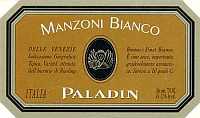
|
|
Manzoni Bianco 2005 |
|
| Paladin (Veneto, Italy) | |
| Grapes: Manzoni Bianco | |
| Price: € 7.50 | Score: |
| This wine shows a pale straw yellow color and nuances of greenish yellow, very transparent. The nose denotes intense, clean, pleasing and refined aromas that start with hints of apple and apricot followed by aromas of banana, litchi, pear, peach, melon, grape, white rose and broom. The mouth has good correspondence to the nose, a crisp attack and pleasing roundness, however balanced by alcohol, good body, intense flavors, agreeable. The finish is persistent with flavors of peach, apricot and litchi. Manzoni Bianco ages in steel tanks. | |
| Food Match: Pasta and risotto with fish and vegetables, Sauteed fish, Sauteed white meat | |
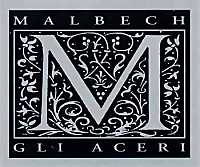
|
|
Malbech Gli Aceri 2001 |
|
| Paladin (Veneto, Italy) | |
| Grapes: Malbec | |
| Price: € 14.00 | Score: |
| Malbech Gli Aceri shows an intense ruby red color and nuances of garnet red, little transparency. The nose reveals intense, clean, pleasing, refined and elegant aromas which start with hints of black cherry, black currant and plum followed by aromas of blueberry, vanilla, tobacco, licorice, chocolate, mace and eucalyptus. The mouth has good correspondence to the nose, a tannic attack and however balanced by alcohol, full body, intense flavors, agreeable. The finish is persistent with flavors of black cherry, plum and black currant. A well made wine. This Malbech ages for 12 months in barrique, 6 months in cask and at least 6 months in bottle. | |
| Food Match: Roasted meat, Braised and stewed meat, Game | |
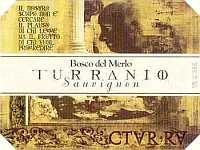
|
|
Lison Pramaggione Sauvignon Turranio 2005 |
|
| Bosco del Merlo (Veneto, Italy) | |
| Grapes: Sauvignon Blanc | |
| Price: € 11.00 | Score: |
| This wine shows a brilliant greenish yellow color and nuances of greenish yellow, very transparent. The nose reveals intense, clean, pleasing and refined aromas which start with hints of peach, elder and pineapple followed by aromas of banana, litchi, apple, pear, bell pepper and tomato leaf. The mouth has good correspondence to the nose, a crisp attack and however balanced by alcohol, good body, intense flavors. The finish is persistent with flavors of peach, pineapple and litchi. Sauvignon Blanc Turranio ages for 5 months in steel tanks. | |
| Food Match: Pasta and risotto with fish and crustaceans, Broiled crustaceans | |
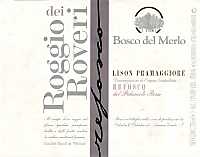
|
|
Lison Pramaggiore Refosco Roggio dei Roveri 2002 |
|
| Bosco del Merlo (Veneto, Italy) | |
| Grapes: Refosco dal Peduncolo Rosso | |
| Price: € 18.00 | Score: |
| This wine shows an intense ruby red color and nuances of garnet red, little transparency. The nose reveals intense, clean, pleasing and refined aromas which start with hints of black currant, black cherry and plum followed by aromas of blueberry, vanilla, tobacco, violet, pink pepper, menthol and cyclamen. The mouth has good correspondence to the nose, a tannic attack and pleasing roundness, however balanced by alcohol, good body, intense flavors. The finish is persistent with flavors of black currant, black cherry and plum. A well made wine. Roggio dei Roveri ages for 18 months in cask followed by 6 months of aging in bottle. | |
| Food Match: Roasted meat, Stewed and braised meat | |
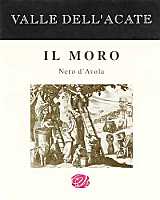
|
|
Il Moro 2004 |
|
| Valle dell'Acate (Sicily, Italy) | |
| Grapes: Nero d'Avola | |
| Price: € 10.50 | Score: |
| Il Moro shows a brilliant ruby red color and nuances of garnet red, little transparency. The nose reveals intense, clean, pleasing and refined aromas which start with hints of black cherry, blackberry and plum followed by aromas of violet, tobacco, carob and menthol. The mouth has good correspondence to the nose, a tannic attack and however balanced by alcohol, good body, intense flavors. The finish is persistent with flavors of plum, blackberry and black cherry. Il Moro ages in steel tanks and in bottle for at least 9-12 months. | |
| Food Match: Broiled meat and barbecue, Sauteed meat with mushrooms, Stuffed pasta, Hard cheese | |
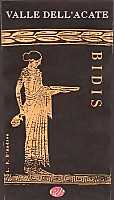
|
|
Bidis 2004 |
|
| Valle dell'Acate (Sicily, Italy) | |
| Grapes: Chardonnay, Inzolia | |
| Price: € 13.50 | Score: |
| Bidis shows a brilliant golden yellow color and nuances of golden yellow, very transparent. The nose reveals intense, clean, pleasing and refined aromas which start with hints of apple, orange and almond followed by aromas of toasted, vanilla, pineapple, peach, hawthorn, broom, plum and pear. The mouth has good correspondence to the nose, a crisp attack and pleasing roundness, however balanced by alcohol, good body, intense flavors. The finish is persistent with flavors of apple, almond and orange. Bidis ages for 12 months in cask followed by 4-6 months of aging in bottle. | |
| Food Match: Roasted fish, Stuffed pasta, Roasted white meat | |
Antonelli San MarcoMontefalco, the affirmed Umbrian wine area, is famous in the world for its powerful Sagrantino. Antonelli San Marco winery, among the most ancient ones, is also one of the protagonists |
|
Umbria is a land of saints and heroes, but also of Sagrantino! This extraordinary autochthonous grape of the Green Heart of Italy, also thanks to the tenacity and will of producers, has been successful in reaching the top of Italian wine, representing Umbria and Italy in the world. A hard way walked in a little more than 30 years, which transformed Sagrantino from a traditional sweet wine, to one of the most interesting dry red wines of Umbria and Italy. It was in fact at the beginning of the 1790s which started the first “experiments” in the production of a dry wine by using that robust and rough grape, with which since centuries was produced in the area of Montefalco a sweet and robust wine which traditionally matched the equally robust roasted meats and hard cheeses. Dry Sagrantino has walked a long way, and today the production in Montefalco is mainly about the dry style instead of the sweet one, climbing to the top of the Olympus of Italian wines.
A great result, if we consider Sagrantino has considerably risked to disappear from Montefalco's vineyards in the period in which other and more famous grapes were catching the attention of local producers, while promising an easier and rich harvest. They began to replace Sagrantino vineyards with other grapes, therefore losing the interest for the historical wine of this place: Sagrantino wine was produced less and less and only thanks to the will of few and stubborn producers, who were affectionate, luckily, to their grape. The name Sagrantino comes from the Latin sacer, therefore sacred, as the wine was traditionally consumed in occasion of Christian holidays, in particular Easter. Pliny the Elder in his monumental Naturalis Historia wrote in this area was present the Itriola grape, however it is not clear whether it was what we call today Sagrantino. In fact, there are no reliable information about the origin of the famous grape of Montefalco. Besides believing Sagrantino is a local indigenous variety of Montefalco, among the hypothesis about its origin, it is also believed this grape was introduced by Saint Francis's followers coming back from Asia Minor, or it could also be introduced during the barbarian invasions of Saracens. Written documents dated back to 1088 AD report about the presence of vineyards in Coccorone - the ancient name of Montefalco - and from the half of the fifteenth century on, strict communal laws were promulgated for the regulation of vineyards' care. From 1540 the date of Sagrantino harvesting was set by a specific communal law. The first important goal for Sagrantino di Montefalco was reached in 1979, when it acquired the Denominazione d'Origine Controllata status (Denomination of Controlled Origin, DOC), followed in 1992 by the Denominazione d'Origine Controllata e Garantita (Denomination of Controlled and Guaranteed Origin, DOCG). Today the wine making reality of Montefalco is flourishing in a continuous development in search of quality, and among the most representative wineries of the area, there is Antonelli San Marco winery, among the most ancient ones in Montefalco.
The place where Antonelli San Marco winery is located was in past times a Longobard court known as San Marco de Corticellis. The ancient court, from the thirteenth to the nineteenth century, was property of the Bishop of Spoleto and the borders of Antonelli San Marco's estate are the same described in a document of the thirteenth century and kept in the episcopal archive of Spoleto. In 1881, Francesco Antonelli, a lawyer from Spoleto, acquired the property and transformed it drastically, including the planting of new specialized vineyards: in a report of 1902 it is read in vineyards were planted 5,000 vines per hectare. In 1979 the winery begins the bottling and commercialization of its wines, which were previously commercialized at wholesale. In 1992, after having restored the “Casale Satriano”, was started the wine tourism activity. The winery and the estate is now property of engineer Antonio Antonelli and lawyer Giacomo Antonelli, both living in Rome. The winery is run since 1986 by Filippo Antonelli, who lives between Montefalco and Rome where he also runs the Castello di Torre in Pietra winery. The estates of Antonelli San Marco covers an area of 170 hectares - of which 40 destined to vineyards - all being located in the commune of Montefalco, in the center of the Sagrantino di Montefalco DOCG production area. The average altitude of vineyards is 350 meters, in hills of clay soils and rich in limestone. Vineyards are mainly exposed to South with a density of 5,700 vines per hectare. The production cellar is found at the center of the winery, under the main building. Recently has been built an underground fermentation room on two levels, in order to allow the vinification and the operation of decanting by gravity, that is without using pumps which would damage the integrity of skins. The harvesting of grapes is done by hand and after crushing, the must is transferred by gravity to the underground rooms where the processes of fermentation and maceration take place. Also the decanting is done by gravity by allowing the wine to go down to the lower room where it will start malolactic fermentation. The wine is then transferred in casks, which are found in the underground rooms, in order to ensure a constant temperature. Antonelli San Marco winery has a total capacity of about 5,500 hectoliters, with an annual production of about 2,000 hectoliters and 270,000 bottles. Antonelli San Marco winery follows its own productive philosophy characterized by the continuous research and improvement of its wines, according to the style of the winery and its typicality, to the balance and elegance, instead of power: a result obtained by delicate extractions and a moderate use of wood. For this reason the casks used for the aging of wines are made from French oak with a fine grain and moderate toasting. For the 25% of red wines which are aged in wood, new casks are being used, whereas the remaining 75% is aged in used casks. Wines produced in this way - in particular Sagrantino - are not “immediate”. In fact, the wines benefits from prolonged aging in bottle therefore giving with time interesting evolutions, confirming the “Antonelli San Marco” style which distinguishes since many years this prestigious winery of Montefalco.
|
||||||||||||||||||||
|
Score legend Prices are to be considered as indicative. Prices may vary according to the country or the shop where wines are bought |
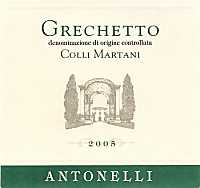
|
|
Grechetto dei Colli Martani 2005 |
|
| Antonelli (Umbria, Italy) | |
| Grapes: Grechetto | |
| Price: € 6.80 | Score: |
| This Grechetto shows a pale straw yellow color and nuances of greenish yellow, very transparent. The nose denotes intense, clean and pleasing aromas which start with hints of apple and plum followed by aromas of hawthorn, pear, lemon and hazelnut. The mouth has good correspondence to the nose, a crisp attack and however balanced by alcohol, good body, intense flavors. The finish is persistent with flavors of apple, pear and plum. This Grechetto ages in steel tanks. | |
| Food Match: Legumes and fish soups, Pasta with meat, Broiled fish | |
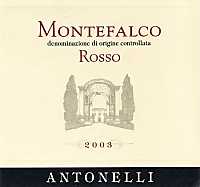
|
|
Montefalco Rosso 2003 |
|
| Antonelli (Umbria, Italy) | |
| Grapes: Sangiovese (65%), Sagrantino (15%), Cabernet Sauvignon (10%), Merlot (10%) | |
| Price: € 10.80 | Score: |
| This Montefalco Rosso shows a brilliant ruby red color and nuances of ruby red, moderate transparency. The nose denotes intense, clean and pleasing aromas that start with hints of black cherry and plum followed by aromas of blackberry, violet, cyclamen and vanilla. The mouth has good correspondence to the nose, a tannic attack and however balanced by alcohol, good body, intense flavors. The finish is persistent with flavors of black cherry and plum. This Montefalco Rosso ages for 9 months in cask, 3 months in cement tanks and for 6 months n bottle. | |
| Food Match: Broiled meat and barbecue, Roasted meat, Stewed meat | |
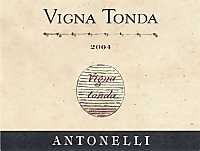
|
|
Grechetto dei Colli Martani Vigna Tonda 2004 |
|
| Antonelli (Umbria, Italy) | |
| Grapes: Grechetto | |
| Price: € 10.80 | Score: |
| This wine shows a brilliant straw yellow color and nuances of greenish yellow, very transparent. The nose reveals intense, clean, pleasing and refined aromas which start with hints of apple, hazelnut and toasted followed by aromas of hawthorn, lemon, yeast, pineapple, pear, plum and vanilla. The mouth has good correspondence to the nose, a crisp attack and pleasing roundness, however balanced by alcohol, good body, intense flavors. The finish is persistent with flavors of plum, hazelnut and apple. Grechetto dei Colli Martani Vigna Tonda ages for 4 months in cask followed by 12 months of aging in bottle. | |
| Food Match: Pasta and risotto with fish, Mushrooms soups, Sauteed white meat, Roasted fish | |
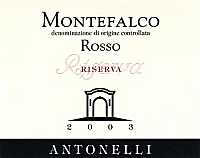
|
|
Montefalco Rosso Riserva 2003 |
|
| Antonelli (Umbria, Italy) | |
| Grapes: Sangiovese (70%), Sagrantino (15%), Cabernet Sauvignon (15%) | |
| Price: € 20.00 | Score: |
| This Montefalco Rosso Riserva shows a brilliant ruby red color and nuances of garnet red, moderate transparency. The nose reveals intense, clean, pleasing and refined aromas that start with hints of black cherry, plum and blackberry followed by aromas of violet, blueberry, vanilla, tobacco, black currant, licorice and menthol. The mouth has good correspondence to the nose, a tannic attack and however balanced by alcohol, good body, intense flavors, agreeable. The finish is persistent with flavors of black cherry, blackberry and plum. This wine ages for 15 months in cask, 3 months in cement tanks and for 12 months in bottle. | |
| Food Match: Roasted meat, Broiled meat and barbecue, Stewed and braised meat, Hard cheese | |
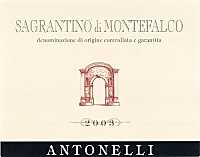
|
|
Sagrantino di Montefalco 2003 |
|
| Antonelli (Umbria, Italy) | |
| Grapes: Sagrantino | |
| Price: € 25.00 | Score: |
| This Sagrantino shows an intense ruby red color and nuances of garnet red, little transparency. The nose reveals intense, clean, pleasing, refined and elegant aromas which start with hints of blackberry, black cherry and plum followed by aromas of violet, blueberry, cyclamen, vanilla, tobacco, pink pepper, licorice, cinnamon and mace. The mouth has good correspondence to the nose, a tannic attack and however balanced by alcohol, full body, intense flavors, agreeable. The finish is persistent with flavors of blackberry, plum and black cherry. A well made wine. This Sagrantino di Montefalco ages for 15 months in cask, 3 months in cement tanks and 12 months in bottle. | |
| Food Match: Game, Roasted meat, Stewed and braised meat, Hard cheese | |
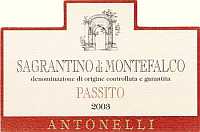
|
|
Sagrantino di Montefalco Passito 2003 |
|
| Antonelli (Umbria, Italy) | |
| Grapes: Sagrantino | |
| Price: € 25.00 - 37.5cl | Score: |
| This Sagrantino di Montefalco Passito shows an intense ruby red color and nuances of garnet red, little transparency. The nose reveals intense, clean, pleasing and refined aromas that start with hints of blackberry, plum and black cherry followed by aromas of blueberry, violet, vanilla, tobacco, chocolate, menthol and mace. The mouth has good correspondence to the nose, a sweet and tannic attack, however balanced by alcohol, full body, intense flavors, pleasing roundness. The finish is persistent with flavors of blackberry, black cherry and plum. This Sagrantino Passito ages for 15 months in cask, 3 months in cement tanks and 12 months in bottle. | |
| Food Match: Fruit desserts, Confectionery, Hard cheese | |
| Antonelli San Marco - Loc. San Marco, 59 - 06036 Montefalco, Perugia (Italy) Tel. +39 742 379158 Fax: +39 742 371063 - Winemaker: Massimiliano Caburazzi with the support of Manlio Erba - Established: 1881 - Production: 270.000 bottles - E-Mail: info@antonellisanmarco.it - WEB: www.antonellisanmarco.it |
Cellar Journal |
|
This section is reserved to wine producers who want to publish news and information about their business, to announce new products or just for communicating to customers information and promotions about their products and activity. Send news to be published to our e-mail address.
|
DiWineTaste on Your Cell Phone!DiWineTaste becomes your personal sommelier, wherever you are and in every occasion, it will always be ready to suggest wines, distillates and restaurants |
|
Are you at the restaurant and you do not know what wine you should choose for your dinner? Are you at a wine shop and you have to buy a bottle of wine to bring at your friend's for dinner but you do not know what to pick? Or in front of a mall's shelf, undecided about the purchasing of a wine or brandy because you do not know the products available there? An advice about a good restaurant in order to spend some good time in company of your friends? No problem. The three DiWineTaste's guides will always be available on your cell phone every time you want it, ready to answer your questions and to clear your doubts! In fact are now available on your cell phone, on mobile devices and palm computers having the access to the internet, the three DiWineTaste's guides: Wines Guide, Aquavitae and Wine Services Directory. By visiting the address http://www.diwinetaste.com/mobile from your cell phone, it will be like having a personal sommelier with you, ready to satisfy your requests, every time you want it and in every occasion. DiWineTaste increases the quality and quantity of services offered to its readers and, just like the main site, the browsing from the cell phone is completely free. The user will only pay for the data traffic generated from his or her cell phone, or mobile device, to the provider, according to the tariff plan, just like every internet connection. As most of tariff plans calculate the cost of the internet connection based on data traffic, the pages available from the cell phone have been created with the specific goal of limiting as much as possible the quantity of data transferred, therefore limiting the connection costs as well. The searching in the three guides have been developed according to the interactive capabilities of mobile devices. The search panels of the three guides have a lesser number of criteria, without limiting the power and versatility of use while offering, at the same time, a simple and immediate use. The next time you are going to the restaurant, or enter a wine shop or mall, remember DiWineTaste is always with you, always available to give you a good advice. Happy browsing from your cell phone! http://www.diwinetaste.com/mobile
|
||||
News |
|
In this section are published news and information about events concerning the world of wine and food. Whoever is interested in publishing this kind of information can send us a mail to our address.
|
Making Wine: Grape HarvestThis is the first article of a series dedicated to enology and wine making, beginning from the initial phase of this enchanting adventure: grape harvest |
|
There are many readers writing to us every month and asking for advices and suggestions about problems concerning the production of wine, a sign the “self” production of the nectar of Bacchus is still an activity done by many wine lovers. Besides appreciating it in glasses, it seems our readers also own a vineyard in which, with the same passion, cultivate vines in order to make wine. The many letters we receive about enology - and we are aware of the fact we cannot answer to all of them, either through the pages of DiWineTaste or personally - convinced us to publish a series of articles expressly dedicated to wine making. Of course we do not have pretensions to transforming our readers in expert wine makers: our goal is more humble, we simply want to provide our readers useful information about home wine making, even better, useful information about home production of a wine with the least possible number of faults.
Before beginning the adventure of home wine making, it is time to write a premise about some concepts which will be part of our articles about enology, being aware of the fact what we are about to write could disappoint some readers as well as not being agreed by many. In our articles we will also talk about chemistry and about its use in wine making, as the connection between the two is so tight - as well as useful - that would be stupid to neglect or deny the use of chemistry in the production of wine. After all, wine is undeniably the result of a series of chemical phenomena, including fermentation, therefore, even in case it will not be used any chemistry at all, wine will do that on its own. We should also say the use of chemistry is agreeable only in case it is used in an indispensable way for the production of a genuine and sound wine, while limiting as much as possible faults and playing an indispensable role in the prevention and prophylaxes. It is absolutely deprecable - and not agreed at all - when chemistry is used in order to adulterate wine, even worse when it is cause of disorders for the body. Chemistry is certainly useful, but it is not a game: it is always and appropriate to use it in the strictly necessary measure. It was probably happen to anyone to taste a home made wine together with the words of the producer who, proudly, emphasized the fact his or her wine was absolutely genuine and to which «nothing was added», as this would be enough to make an excellent nectar. Although we understand the proud and pleasure in offering a home made wine, produced with passion and conviction, it usually happens that in the glass one sometimes find a wine which is to the limit of being drinkable, sometimes disgusting as well, with evident and serious faults a better prevention and care could have helped to avoid. The most probable cause is that to the wine nothing was added and nothing was done in order to prevent and avoid faults. What we want our readers understand is that a wine is made - first of all - by having a good prime matter: grape. To make a good wine, grape, and therefore its juice, must be ruined the least possible, while preventing the unavoidable negative chemical reactions which take place - naturally or in presence of specific factors - from crushing to bottling. Chemistry, of course used in the right way in enology, must exclusively be used for this: to ensure the integrity of the must and wine, while preventing as much as possible the development of faults and defects, therefore ensuring a better and fundamental hygiene, an indispensable factor for quality.
|
||||||||
|
Like we said, in order to make a good wine, it is indispensable to have, first of all, quality grapes. When quality grapes are available, the only preoccupation is to process them properly, limiting as much as possible to worsen its quality. This unpleasing inconvenience inevitably happens when the appropriate measures of prevention and prophylaxes are not used. Once again, it is good to remember wine is the result of a series of complex chemical processes, positive and negative ones for quality, and it is therefore appropriate to limit and prevent the negative ones while favoring the positive ones. If it is true a quality grape can only be ruined, the opposite it is not true: a bad quality grape cannot be improved and you cannot expect to make a good wine from it. The old saying “wines is made first of all in the vineyard” represents an indisputable truth. Moreover, having quality grapes - sound, with no faults or molds - not only means obtaining a better wine, but also making a limited use of chemistry. The determination of the harvesting period fundamentally depends on two main factors: the integrity of grapes and in particular the presence of mold; the type of wine to be made. The moment of harvesting is usually determined when the grape is considered to be sufficiently ripe or when it reaches its highest level of ripeness expressed by its content in sugar. This condition can be achieved only in case the grapes are perfectly sound: in case of the presence of mold in berries, its development compromises the quality and health of grape, forcing to advance the date of harvesting. The control of grape ripeness is more complex, as it is necessary to do analyses about the quantity of the main components in relation to the type of wine to be made. The typical condition for home wine making does not require, generally speaking, the availability of special equipments in order to do accurate analyses on the grapes - and in particular on acidity - before proceeding with harvesting. The type of analysis done in these cases - also representing a fundamental examination - is about the quantity of sugar, a measure considered to be enough at the time of harvesting for home wine making. At the time of harvesting, it is important the grape has the best balance among its essential components and represented by sugar, acids and coloring substances. During the ripening process, in grapes take place the following phenomena:
The best balance is not always represented by the condition in which the grape reached the highest level of ripeness, that is by the highest quantity of sugar possible. There are cases in which it is better to keep a higher quantity of acids, such as in case of the production of base wines for sparkling wines, or in case of particular grapes whose wines are more agreeable with an appreciable acidity, such as Sauvignon Blanc. Moreover, it should be remembered acidity offers a good support for the perception of aromas and, last but not the least, represents a fundamental requisite for white wines. By exclusively considering white and red wines, as an example, can be defined the following three generic cases:
|
||||
|
Despite the type of analysis to be done on the grape in order to determine the period of harvesting, it is indispensable to prepare a representative and statistically reliable sample. As the determination is based on the analyses done on samples measured few days apart one from another, it is best to write down the result of every analysis in order to have fundamental elements for a comparison. Grape berries, from which it will be obtained the must to be analyzed, will be picked from one or more rows, from different vines, possibly avoiding the external rows. In order to have a reliable measure, 250ml of grape juice will be enough. Particular care will be paid to the picking of berries from different parts of the plant and with different expositions. Berries are then crushed, preferably with a small press, in order to obtain a juice containing all the main elements in representative and significative quantity. On this regard, it should be remembered a soft crushing will make a juice rich in sugar and poor in acid. The must is then poured in a test tube, or in a small clean glass jar, and it is allowed to rest for some minutes in order to decant and in order to let solid parts to deposit on the bottom. Alternatively, it can be filtered by using some cotton wool.
|
|
The analysis of sugar, besides allowing the determination of the ripeness levels of the grape, also allows the calculation of the probable content of alcohol at the end of alcoholic fermentation. The determination of sugar in a sample of must can be done in two ways, both easily usable in home wine making. The first method consists in using a densimeter, of which the most common one is the Babo densimeter. As the density of a liquid changes according to temperature, it is appropriate to know the reference temperature at which the densimeter was calibrated to. The reference temperature is usually 20° C, therefore the measure of a must at a different temperature from the one of calibration, gives a result that must be properly corrected. In order to get the right measure, it is added or subtracted 0.06 for every degree in excess or in defect from 20° C. The measure is done by filling the densimeter's tube with the sample to be measured, while paying attention to not get any foam, until it is completely filled, therefore it is measured the temperature. It is then introduced the densimeter in order to spill the must in excess while paying attention it does not touch the side of the tube. The result can be read by reading the value from the scale relative to the floating point at the surface.
The value read on the densimeter refers to the so called “Babo” degree, where each degree corresponds to 10 grams of sugar in 1000 grams of must. In order to calculate the probable quantity of alcohol after the end of alcoholic fermentation, it is enough to subtract 4 from Babo degrees and multiply by 0.85 in case of white wines, 0.80 in case of red wines. It should be remembered this is however an approximate value. The second method for the determination of sugar in the must makes use of a refractometer, which also offers the advantage of a more reliable result than the densimeter as it is not altered by the density of other solid substances found in the must besides sugar. Moreover, refractometer allows a more practical and immediate measure, it requires few drops of the must, however it should be considered, in order to have a reliable measure, they must be taken from a significative sample, as explained above. A portable refractometer, which can be used to measure samples directly in the vineyard, generally gives values in Brix, Babo and Oechsle degrees, thanks to the presence of the relative three scales. Refractometers are generally calibrated to the measuring of samples at a temperature of 20° C, however the most modern and common models automatically provide for the proper corrections according to temperature, therefore giving a directly usable value. The measure with a refractometer is done by lifting the transparent shield, then few drops are put over the prism, then the transparent shield is closed while paying attention it adheres perfectly and that must drops are uniformly distributed. In order to get a more accurate measure, it is best to wait about 30 seconds in order to allow the must to reach the same temperature of the refractometer. At this point the refractometer is pointed towards a natural light source and the result is read by directly looking through the eyepiece, properly correcting the view until sharp, just like a telescope. Before and after measuring every sample, it is indispensable to clean both the prism and the transparent shield with distilled water, perfectly drying and wiping it with a cotton cloth. The measure of samples will be done every two or three days, carefully writing down the result of each analysis. Despite the measuring method used, the harvest will be done when the value of the last analysis is equal to the ones of the next to last analysis. This condition indicates the full ripeness of grapes, that is the highest quantity of sugar and acid, however remembering that, as the ripening process goes on - therefore getting overripe - acid will decrease in quantity while compromising the overall balance of the must. A good habit is to keep an archive of all measures in order to compare them in the following years: an useful reference about the vineyard over time.
|
||||||||
|
The rule “a good wine is obtained by a good grape” must be scrupulously followed during the operation of harvesting as well. This means the grape must arrive to the cellar sound and undamaged, while paying attention to not crush the clusters with the subsequent loss of juice from the berries. The harvesting is done by using specific scissors, by cutting clusters at the stem and gently laying them in a small harvesting basket. The basket is then emptied in small cases containing about 15-20 kilograms, in order not to crush the clusters on the bottom because of the weight of the ones over them. During the harvest, it will be paid attention on the quality of clusters, therefore rejecting the ones affected by mold or however damaged or faulty, in order not to spoil the must and therefore the wine. The cases will finally be transported to the cellar where the grape will be subsequently crushed and destemmed, therefore obtaining the must which will become your wine.
|
AvocadoA particular fruit which perfectly accompanies salty recipes and salads, its fame of aphrodisiac has accelerated its spreading from America to Europe |
|
Avocado, Persea americana Mill., it is a plant belonging to the Lauraceae family, genus Persea, coming from Central America, known before the pre-columbian era. Its origins are believed to be around 5,000 b.C. and the name derives from Spanish “avogado”, which in turn derives from the Aztec terms “ahuacatl”, “aguacate” or “ahuacate” (testicle). Because of its particular shape and color of the skin, it is also called “alligator pear”. Avocado is cultivated in tropical countries and with a tempered climate, such as Mexico, California, Florida, Venezuela, Australia, Philippines, Kenya, New Zealand, Brazil and South Africa. In the Mediterranean area it is found a small production in Spain and in Israel.
Avocado is a tree of about 20 meters in height (about 65 feet), with a wide crown having a sphere shape, evergreen leaves, small flowers and not very noticeable, with six greenish yellow petals grouped in clusters. Fruits are not very showy and are not very visible to insects, therefore determining the low productivity. Fruits are fleshy large berries, from 7 to 20 centimeters long (2.5-8 inches), with a pear like shape, the external skin, according to variety, has a green, black-purple or coffee color, rough at the touch. The pulp has a greenish yellow or pale yellow color, with buttery consistence because of the high content in fats, it wraps one whitish or pink seed. According to a botanical point of view, it is an evergreen plant, although near the blossoming period, it tends to lose almost all of its leaves. Avocado can be adapted to tropical, subtropical and tempered climates, however in lands exposed to wind, proper measures must be taken in order to shield the plants.
|
||||||||
|
The varieties of avocado are three: Antillian, Guatemalan and Mexican. The main differences are shown in the leaves: the sprouts of the Mexican and Antillian varieties are green, whereas in the Guatemalan variety have a green bronze-purple color. The Mexican variety has the typical aroma of anise. The most resistant varieties are the Mexican and Guatemalan, however they do not stand to temperatures lower than 4° C (39° F). The avocados cultivated in modern plantations do not show these differences, as in most of the cases they are hybrids. The hybrids used in cultivations, although they have hermaphrodites flowers, are characterized by a high difficulty in self-fecundation. Plants are divided in two categories: “A” and “B”. They differ from floral biology: in plants belonging to type “A”, the receptivity of the pistil is active during morning hours, when the anthers are folded and pollen cannot reach its destination; in plants belonging to type “B” happens the opposite. In case it is wanted to obtain a production of avocados, it is indispensable to have both variety “A” and “B”. The most commercialized varieties are:
Avocado can be considered a plant with a quick growth, at least when compared to citrus fruits: in three years a plant of avocado grows as much as a plant of citrus fruits do in ten. Plantations of avocado do not require particular cares. The harvesting period begins in November and usually ends in March or April, according to variety. Also yields changes according to varieties, usually about 10-20 tons per hectare. Every fruit usually weigh from 200 to 500 grams (7-17 ounces). Leaves provide fruits a hormone which avoids full ripeness: in order to get them ripe it is then necessary to remove them from the plant. Avocado was one of the base foods for Aztec and Maya people, where it was considered aphrodisiac, a characteristic which did not pass unnoticed to Spanish conquerors who planted it in Europe, as well as importing the legends which made it famous. Avocado oil is used for massages; the oil with a pale yellow color is more refined and it is used for massaging the face, whereas the green or brown one, less refined, it is used to massage the body.
|
|
Avocado is one of the few fresh fruits very rich in fats and poor in simple sugars. Because of its high content in calories, it is advisable to limit its consumption, in fact, 100 grams provides more than 200 calories. Most of the cases, it provides mono-unsaturated fats, whereas it has a small quantity of poly-unsaturated fats. For this reason, avocado cannot be considered a balanced source of essential fats. Avocado is a good source of antioxidants, such as vitamin E and glutation, it is rich in vitamin A, B1 and B2; it is good against aging, for the skin and eyes. The consumption can be advised for the ones following a vegetarian diet, in case of convalescence, aging and pregnancy. Because of its high contents in mucillagins, it is advised to the ones suffering from colitis or gastritis, and thanks to its antioxidant properties, it can be useful against precocious aging. Recently has been discovered avocado favors the absorption of alpha-carotenes and beta-carotenes. One hundred grams of avocado contains: 83% edible part; 64g water; 2.2g proteins; 17g lipids; 6g sugars; 1.5g fibers; 4mg sodium; 340mg potassium; 0.6mg iron; 10mg calcium; 42mg phosphor; 14mg vitamin A; 0.11mg vitamin B1; 0.2mg vitamin B2; 18mg vitamin C; 6.4mg vitamin E; 1.6mg vitamina PP. Besides its nutritional qualities, avocado is also known for its cosmetic properties. Women in South and Central America used avocado for the preparation of masks particularly effective on dry skin and for the hair. It also has digestive properties, indicated against dysentery thanks to its astringent qualities.
|
||||
|
Avocado usually is an imported fruit, therefore it is not always easy to find good quality fruits, they are usually sold unripe and therefore they need to get ripe before consumption. Before buying one, it is enough to take it on hands and to do a slight pressure with the thumb on the surface of the fruit: in case it is hard, it means it is still unripe and it takes some time in order to get ripe, usually few days. In case in the skin remains a hole with no wrinkles, it is the right time to consume it. In case in the skin remains a hole and a wrinkle, it means it is overripe and it should be used for the preparation of creams. In case in the skin remains a deep wrinkle, it means it is too much ripe and it should not be purchased. In case are being bought unripe fruits, it is suggested to leave them at room temperature from three to six days, never in the fridge. In order to accelerate the ripening process, it is enough to put them in a paper bag together with a tomato or wrapped with aluminum foil. In case a ripe avocado was bought, it can be kept in the fridge for one or two days. To open an avocado, take a sharp knife and cut the fruit on halves, vertically, by cutting around the hard seed with the knife, then the two halves are taken in the hands and it is done a light twist, clockwise with one hand, opposite direction with the other. The pulp in contact with air gets dark: in order to avoid this inconvenience it is enough to sprinkle it with some lemon juice. Avocado is a fruit which can be consumed as a vegetable. The pulp cut in small pieces or slices, can be seasoned with oil, pepper, salt, vinegar, mustard, garlic or mayonnaise sauce. The pulp can also be mashed and spread on bread slices. The pulp cut in small pieces can be added to salads. In case it is being prepared a cream, it is advisable to cover it with a film in order to avoid as much as possible the contact with oxygen. In Philippines avocado is served as a dessert by adding milk and sugar. Finally, from the seed is being obtained an edible oil.
|
AquavitaeReview of Grappa, Distillates and Brandy |
|
|
| Distillates are rated according to DiWineTaste's evaluation method. Please see score legend in the "Wines of the Month" section. |

|
|
Grappa di Sagrantino |
|
| Antonelli (Umbria, Italy) | |
| (Distiller: Distilleria Nannoni) | |
| Raw matter: Pomace of Sagrantino | |
| Price: € 20.00 - 50cl | Score: |
| The grappa is colorless, limpid and crystalline. The nose denotes intense, clean and pleasing aromas of blackberry, plum, licorice, violet and hints of anise with almost imperceptible alcohol pungency. In the mouth has intense flavors, perceptible alcohol pungency which tends to dissolve rapidly, balanced sweetness, dry taste. The finish is persistent with flavors of blackberry and plum. This grappa is distilled with a bainmarie alembic still. Alcohol 43%. | |
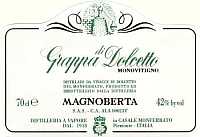
|
|
Grappa di Dolcetto Monovitigno |
|
| Magnoberta (Piedmont, Italy) | |
| Raw matter: Pomace of Dolcetto | |
| Price: € 15.50 - 70cl | Score: |
| This grappa is colorless, limpid and crystalline. The nose reveals intense, clean, pleasing and refined aromas of cherry, raspberry, plum, strawberry and hazelnut with almost imperceptible alcohol pungency. In the mouth has intense flavors, perceptible alcohol pungency which tends to dissolve rapidly, balanced sweetness, intense flavors, agreeable roundness. The finish is persistent with flavors of cherry and raspberry. This grappa is produced with a discontinuous alembic still operating at low pressure. Alcohol 42%. | |

|
|
Grappa di Teroldego 2004 |
|
| Zeni (Trentino, Italy) | |
| Raw matter: Pomace of Teroldego | |
| Price: € 19.00 - 70cl | Score: |
| This grappa is colorless, limpid and crystalline. The nose reveals intense, clean, pleasing, refined and elegant aromas of black cherry, plum, raspberry, hazelnut, licorice and violet with almost imperceptible alcohol pungency. In the mouth has intense flavors, perceptible alcohol pungency which tends to dissolve rapidly, balanced sweetness. The finish is persistent with flavors of black cherry, plum and raspberry. This grappa is distilled with a discontinuous bainmarie alembic still. Alcohol 45%. | |

|
|
Grappa Rubinia 1998 |
|
| Distilleria Gualco (Pidemont, Italy) | |
| Raw matter: Pomace of Dolcetto of Ovada and Barbera | |
| Price: € 34.50 - 70cl | Score: |
| This grappa shows a pale amber yellow color, limpid and crystalline. The nose denotes intense, clean, pleasing and refined aromas of dried fig, vanilla, prune, licorice, tobacco, hazelnut and honey with almost imperceptible alcohol pungency. In the mouth has intense flavors, perceptible alcohol pungency which tends to dissolve rapidly, balanced sweetness, pleasing roundness. The finish is persistent with flavors of prune, dried fig and honey. This grappa is distilled with a discontinuous bainmarie alembic still, it ages for 2 years in oak casks and for 3 years in acacia casks. Alcohol 42%. | |
Wine Parade |
|
|
| The best 15 wines according to DiWineTaste's readers. To express your best three wines send us an E-mail or fill in the form available at our WEB site. |
| Rank | Wine, Producer | |
|---|---|---|
| 1 |
| Amarone della Valpolicella Classico 2000, Zenato (Italy) |
| 2 |
| Wine Obsession 2001, Vignamaggio (Italy) |
| 3 |
| Brunello di Montalcino 1999, Castello Banfi (Italy) |
| 4 |
| Notarpanaro 1999, Taurino (Italy) |
| 5 |
| Colli Orientali del Friuli Rosazzo Bianco Terre Alte 2002, Livio Felluga (Italy) |
| 6 |
| Chianti Classico Riserva Novecento 2000, Dievole (Italy) |
| 7 |
| Nero al Tondo 2001, Ruffino (Italy) |
| 8 |
| Trento Talento Brut Riserva Methius 1998, Dorigati (Italy) |
| 9 |
| Chianti Classico Riserva Novecento 2000, Dievole (Italy) |
| 10 |
| Don Antonio 2003, Morgante (Italy) |
| 11 |
| Riesling Central Otago 2004, Felton Road (New Zealand) |
| 12 |
| Amarone della Valpolicella Classico Costasera 2001, Masi (Italy) |
| 13 |
| Sagrantino di Montefalco Collepiano 2003, Arnaldo Caprai (Italy) |
| 14 |
| Soave Classico Monte Alto 2004, Ca' Rugate (Italy) |
| 15 |
| Amarone della Valpolicella Classico 1998, Santa Sofia (Italy) |
| |||||||
Privacy Policy | |||||||


| Copyright © 2002-2024 Antonello Biancalana, DiWineTaste - All rights reserved |
| All rights reserved under international copyright conventions. No part of this publication and of this WEB site may be
reproduced or utilized in any form or by any means, electronic or mechanical, without permission in writing from DiWineTaste. |